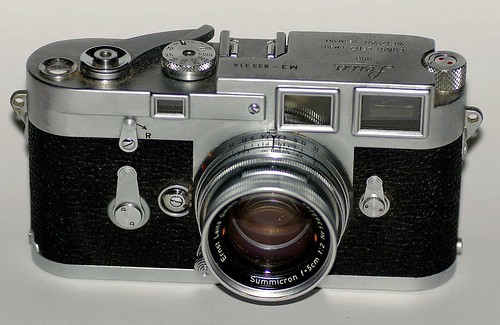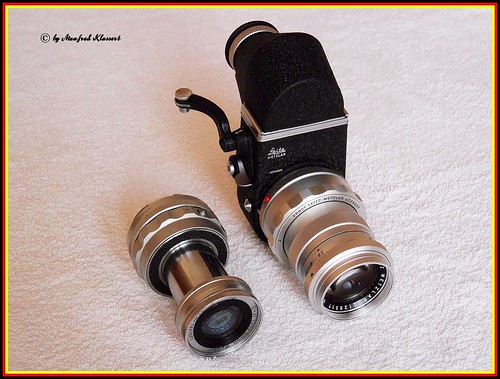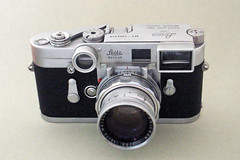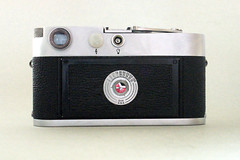Difference between revisions of "Leica M3"
m (→Bayonet mount versus screw mount: better caption format with image-author attribution template) |
m (Updated LPA links) |
||
| (41 intermediate revisions by 7 users not shown) | |||
| Line 1: | Line 1: | ||
| − | {{ | + | {{Infobox_35mm_RF_system|camera name='''Leica M3''' |
| − | | | + | |image source=http://www.flickr.com/photos/rst90274/262897065/in/pool-camerawiki/ |
| − | |image= http://farm1.static.flickr.com/103/262897065_359e2bbe5f.jpg | + | |image=http://farm1.static.flickr.com/103/262897065_359e2bbe5f.jpg |
| − | | | + | |image caption=image by {{image_author|rst12}} {{with permission}} |
| − | | | + | |maker=[[Leica]] |
| − | | | + | |dates=1954-1968 |
| − | | | + | |variants=silver-black |
| − | + | |viewfinder=Reverse Galilean (0.90×) | |
| − | | | + | <br/>with automatic or manual selection of [[parallax|parallax corrected]] framelines |
| − | | | + | |rangefinder=[[coupled rangefinder|coupled]], combined ([[rangefinder base|ERB]] = 47.1mm) |
| − | | | + | |lens mount=Leica M |
| − | | | + | |shutter type=[[focal plane shutter|focal plane]]<br>cloth curtains, horizontal travel |
| − | | | + | |min shutter speed=1/1000 |
| − | | | + | |max shutter speed=1s |
| − | + | |exposure meter=None | |
| + | |exposure modes=manual | ||
| + | |iso range=160 to 2500 [[ASA|ISO]] | ||
| + | |shoe=fixed | ||
| + | |sync=X | ||
| + | |sync speed=1/50 | ||
| + | |ttl flash=No | ||
| + | |motor drive=No | ||
| + | |battery=None | ||
| + | |dimensions=138×77×38mm | ||
| + | |weight=550g | ||
| + | |number produced=unknown | ||
| + | }} | ||
The '''[[Leica]] M3''' was introduced in 1954. It was a new starting point for [[Leitz]], which until then had only produced [[Leica screw mount|screw-mount Leica cameras]] that were incremental improvements to its original Leica (''[[Ur-Leica]]''). Leica M cameras are still in production today. The M3 introduced several features to the Leica, among them the combination of [[viewfinder]] and [[rangefinder (device)|rangefinder]] in one bright window, and a bayonet lens mount. | The '''[[Leica]] M3''' was introduced in 1954. It was a new starting point for [[Leitz]], which until then had only produced [[Leica screw mount|screw-mount Leica cameras]] that were incremental improvements to its original Leica (''[[Ur-Leica]]''). Leica M cameras are still in production today. The M3 introduced several features to the Leica, among them the combination of [[viewfinder]] and [[rangefinder (device)|rangefinder]] in one bright window, and a bayonet lens mount. | ||
| − | + | Early M3 cameras had two throw film advance (two wind movements of the film advance lever) and German shutter speed series (1/25, 1/50, 1/100, etc), which later changed to single throw film advance and international shutter speeds. | |
| − | This new bayonet mount, which has not been changed in the following half century, is called the [[Leica M mount]]. Lenses | + | ==M series== |
| + | The main models of the M series, with their variations, are as follows. Note that the M2 and M1 were later versions of the M3, and the [[Leica M4|M4-2]] and [[Leica M4|M4-P]] developments of the [[Leica M4|M4]] succeeded the [[Leica M5|M5]]: | ||
| + | * M3 (M2 and M1) | ||
| + | * [[Leica M4|M4]] (later M4-2 and M4-P) | ||
| + | * [[Leica M5|M5]] | ||
| + | * [[Leica M6|M6]] (2003 MP) | ||
| + | * [[Leica M7|M7]] (electronic) | ||
| + | * [[Leica M8|M8]] (digital) | ||
| + | * [[Leica M9|M9]] (digital) | ||
| + | * [[Leica M|M]] (digital) | ||
| + | |||
| + | Except the M5, all models share similar overall dimensions. Accessories, such as the clip on light meter and Visoflex reflex head, will fit most of the versions. | ||
| + | |||
| + | ===Lens mount=== | ||
| + | This new bayonet mount, which has not been changed in the following half century, is called the [[Leica M mount]]. Lenses can be changed faster than with a screw mount and framelines set automatically. An adapter also allows the use of [[39mm screw lenses|M39]] screwmount lenses. | ||
{|class=plainlinks | {|class=plainlinks | ||
| Line 26: | Line 52: | ||
||[http://www.flickr.com/photos/raulm/3333817402/in/pool-camerawiki/ http://farm4.static.flickr.com/3341/3333817402_6bf23eaf29_m.jpg] | ||[http://www.flickr.com/photos/raulm/3333817402/in/pool-camerawiki/ http://farm4.static.flickr.com/3341/3333817402_6bf23eaf29_m.jpg] | ||
|- | |- | ||
| − | |colspan=4 align=center| < | + | |colspan=4 align=center|M3 on the left fitted with Leicameter MR<br/>Images by {{image author| Raúl Sá Dantas}} {{with permission}} |
|} | |} | ||
| − | == | + | === Viewfinder === |
{{Flickr_image | {{Flickr_image | ||
| − | |image_source= http://www.flickr.com/photos/solid_max/4494638388/in/pool- | + | |image_source= http://www.flickr.com/photos/solid_max/4494638388/in/pool-camerawiki |
|image= http://farm5.static.flickr.com/4053/4494638388_d1cab5fcb9_m.jpg | |image= http://farm5.static.flickr.com/4053/4494638388_d1cab5fcb9_m.jpg | ||
|image_align= right | |image_align= right | ||
| − | |image_text= Leica M3, image by | + | |image_text=M3 fitted with viewfinder "spectacles" |
| + | |image_by=M*LoW - Massimo | ||
| + | |image_rights= wp | ||
| + | }} | ||
| + | Compared to the preceding [[Leica IIIf|IIIf]], the M3 has an exceptionally bright viewfinder. It also has a high magnification factor, which is very useful in critical focusing. The M3 has a factor of 0.90×, while other Leicas use 0.85×, 0.72×, or less. Furthermore, it was the first Leica to combine [[rangefinder (device)|rangefinder]] and viewfinder into one window (other cameras, such as the [[Contax II]], already had this feature before the war and other companies were making screwmount bodies with combined viewfinders). Framelines for 50, 90 and 135mm are shown, although none for any wider lenses. However, Leica solved this problem in two different ways. One was using a separate viewfinder slid into the accessory shoe. The other way is the use of so called ''Leica glasses''; auxiliary lenses are put in front of the viewfinder and rangefinder windows for the 35mm focal length. The drawback of these glasses is they reduce the famed brightness of the finder. | ||
| + | |||
| + | The later M2 with its reduced viewfinder magnification of 0.72× and framelines for 35, 50, and 90mm lenses was introduced primarily at the request of photojournalists who frequently used wide angle lenses. | ||
| + | |||
| + | The 50 mm framelines are always visible in the slightly larger viewfinder image. There are two ways to select the 90mm or 135mm framelines. Mounting a 90mm lens will automatically select the corresponding framelines. The other way is toggling a small lever on the left of the lens. This way, the tele-framelines for other lenses can be seen when using a 50mm lens, which shows the field of view for another focal length. | ||
| + | |||
| + | [[Viewfinder camera]]s don't show exactly the same image in the viewfinder as on film ([[parallax]] error) which is compensated in the M3 by moving the framelines when focussing the lens. At very close distances this compensation is no longer effective. | ||
| + | |||
| + | ===Film transport=== | ||
| + | Leica IIIf and its predecessors had used a knob to advance the film. For fear of tearing the film, early M3s had a double stroke advance lever, just as the [[Neoca 2S]] had. Later models had single-stroke levers, which speeded up operation of the camera. Another variation is in the film pressure plate. Early models used a glass plate to keep the film flat, later models used a metal plate. | ||
| + | |||
| + | === Shutter === | ||
| + | Focal plane shutter, horizontal travel with cloth curtains. Earlier screw mount Leicas had two shutter controls with separate slow and fast speeds which rotated on exposure, as on the [[Exakta Varex]]. The M3 combined all speeds on a single static dial, partly to reduce vibrations in the camera. | ||
| + | |||
| + | ==M2, M1, and MD== | ||
| + | {|class=floatright | ||
| + | | | ||
| + | {{Flickr image | ||
| + | |image_source=http://www.flickr.com/photos/diong/3390553520/in/pool-camerawiki | ||
| + | |image=http://farm4.static.flickr.com/3630/3390553520_90f19a83f9.jpg | ||
| + | |image_align=right | ||
| + | |image_text=The M2 was a revised M3 variant of 1958 | ||
| + | |image_by=Dennis Leonardo | ||
| + | |image_rights=wp | ||
}} | }} | ||
| − | + | |} | |
| − | + | Leica's model numbering scheme has often caused confusion among users and collectors alike. The next model introduced by Leica was the M2. This was the M3 with reduced viewfinder magnification and a different selection of viewfinder framelines (35, 50, and 90mm). These changes were suggested by professional photojournalists, who were Leica's primary customers at the time. The self timer was initially omitted, but reinstated on later production. | |
| − | + | A variant was the M2-Mot introduced in 1967, which could be fitted with a motor winder or the Leicavit rapid winder. The winder with its battery case was larger than the camera body itself. | |
| − | + | The M2 was sold alongside the M3 and both continued production with minor changes until eventually replaced by the [[Leica M4|M4]]. | |
| − | |||
| − | + | The M1 was also based on the M3 body but without a rangefinder, significantly reducing cost. | |
| − | |||
| − | + | The MD had no viewfinder at all and was primarily intended to be mounted on a microscope or telescope for use as a scientific instrument camera. | |
| − | + | {{br}} | |
| − | + | ==MP== | |
| + | Produced in limited numbers from 1956-57 and available only to established professional photographers. This version of the M3 incorporated the Leicavit rapid winder (manually operated lever on the base) which could not be fitted to the normal M3.<ref name=LPA41>Examples offered for sale at the [https://www.leitz-auction.com/en/Cameras/Past-Auctions/Auction-41/ 41st Leitz Photographica Auction], in November 2022 - several excellent detail photographs of each camera:<br/> | ||
| + | *[https://www.leitz-auction.com/en/Leica-MP-chrome-no.-MP-157/AI-41-41076 MP serial no. 157]<br/> | ||
| + | *[https://www.leitz-auction.com/en/Leica-MP-chrome-no.-MP-338/AI-41-41020 MP serial no. 388]</ref> | ||
| + | |||
| + | Due to the small number produced this version is highly prized by collectors. | ||
| + | |||
| + | ==Accessories== | ||
| + | {|class=floatright | ||
| + | | | ||
| + | {{Flickr_image | ||
| + | |image_source= http://www.flickr.com/photos/aldabra42/4738549233/in/pool-camerawiki | ||
| + | |image= http://farm5.static.flickr.com/4077/4738549233_d1c87413b9.jpg | ||
| + | |image_align= right | ||
| + | |image_text= Leitz Visoflex (right) matched with 90mm Elmarit,<br>compared to collapsible Elmar 90mm in standard M mount | ||
| + | |image_by= aldabra42 | ||
| + | |image_rights= with permission | ||
| + | }} | ||
| + | |} | ||
| + | Special accessories were available to extend the cameras functionality: | ||
| + | |||
| + | The Leicameter MR exposure meter clipped on the to flash shoe and coupled with the shutter dial, providing semi-coupled metering (aperture still had to be manually set on the meter). | ||
| + | |||
| + | The Visoflex reflex housing turned the camera into an [[SLR]]. The bayonet mount was the same but with extended lens mount to film plane distance. Normal M lenses could only be used on the Visoflex for close up photography, otherwise special Visoflex lenses with reduced back focus length could be used for normal photography. Visoflex lenses could not be used directly mounted on the camera. | ||
| + | |||
| + | Supplementary viewfinder lenses, often called viewfinder "spectacles", alter magnification for different lenses or close up work. | ||
| + | |||
| + | The Leicavit manually operated rapid winder can be fitted to the M2, but not the M3. The standard base plate is replaced by the winder, which has a fold out lever in the base operated by the right hand, while the left hand works camera controls. Up to three frames per second can be exposed using the Leicavit, which does not require batteries. | ||
| + | {{br}} | ||
| + | |||
| + | ==Notes== | ||
| + | <references/> | ||
== Links == | == Links == | ||
In English: | In English: | ||
| + | *[https://www.butkus.org/chinon/leica/leica_m1/leica_m1.htm Leica M1 user manual] at [https://www.butkus.org/chinon/ Butkus.org] | ||
| + | *[https://www.butkus.org/chinon/leica/leica_m2/leica_m2.htm Leica M2 user manual] at [https://www.butkus.org/chinon/ Butkus.org] | ||
| + | *[https://www.butkus.org/chinon/leica/leica_m3/leica_m3.htm Leica M3 user manual] at [https://www.butkus.org/chinon/ Butkus.org] | ||
| + | *A [https://www.flickr.com/photos/vox/52433209116/in/pool-camerawiki/ profile at launch of the Leica M3] in the June, 1954, ''(Popular) Photography'' magazine, pgs. 94; 120-121. | ||
* [http://antiquecameras.net/leicamcameras.html The Leica M Camera Price Guide] | * [http://antiquecameras.net/leicamcameras.html The Leica M Camera Price Guide] | ||
| − | * [ | + | * [https://cameraquest.com/mtype.htm The Leica M3 within Stephen Gandy's Leica M guide] |
* Leica M3 listed at number 10 in [http://shutterbug.com/equipmentreviews/classic_historical/0708classic/ Jason Schneider's Top 20 Cameras Of All-Time] on [http://shutterbug.com/ Shutterbug]. | * Leica M3 listed at number 10 in [http://shutterbug.com/equipmentreviews/classic_historical/0708classic/ Jason Schneider's Top 20 Cameras Of All-Time] on [http://shutterbug.com/ Shutterbug]. | ||
* [http://www.pentax-manuals.com/manuals/service/leica%20basic%20repair.pdf Servicing M series Leicas], at [http://www.pentax-manuals.com/ Pentax Manuals] | * [http://www.pentax-manuals.com/manuals/service/leica%20basic%20repair.pdf Servicing M series Leicas], at [http://www.pentax-manuals.com/ Pentax Manuals] | ||
| + | * [http://www.luistriguez.es/fotos/cameras/leica_m3/index-leica_m3.htm Leica M3 single stroke] by luis triguez | ||
| + | |||
In Spanish: | In Spanish: | ||
* [http://www.hugorodriguez.com/articulos/leicam3.htm Leica M3] in the [http://www.hugorodriguez.com/ website of Hugo Rodriguez] | * [http://www.hugorodriguez.com/articulos/leicam3.htm Leica M3] in the [http://www.hugorodriguez.com/ website of Hugo Rodriguez] | ||
In French: | In French: | ||
| − | * [http://www.summilux.net/ | + | * [http://www.summilux.net/materiel/Leica-M3 Leica M3] at [http://www.summilux.net summilux.net] |
| − | *[http://www.collection-appareils.fr/ | + | *[http://www.collection-appareils.fr/x/html/page_standard.php?id_appareil=11434 Leica M3 1955] on [http://www.collection-appareils.fr/general/html/francais.php www.collection-appareils.fr] by Sylvain Halgand |
| + | |||
---- | ---- | ||
| Line 76: | Line 165: | ||
[http://www.flickr.com/photos/50678983@N00/2115436285/in/pool-camerawiki/ http://farm3.static.flickr.com/2219/2115436285_843815e2b3_m.jpg] | [http://www.flickr.com/photos/50678983@N00/2115436285/in/pool-camerawiki/ http://farm3.static.flickr.com/2219/2115436285_843815e2b3_m.jpg] | ||
[http://www.flickr.com/photos/50678983@N00/2116210796/in/pool-camerawiki/ http://farm3.static.flickr.com/2284/2116210796_0c91126d78_m.jpg] | [http://www.flickr.com/photos/50678983@N00/2116210796/in/pool-camerawiki/ http://farm3.static.flickr.com/2284/2116210796_0c91126d78_m.jpg] | ||
| − | </div>< | + | </div><small>images by {{image author|Dries van den Elzen}}</small> {{with permission}} |
| + | |||
[[Category: German 35mm rangefinder]] | [[Category: German 35mm rangefinder]] | ||
[[Category: Leica M mount]] | [[Category: Leica M mount]] | ||
| − | [[Category: Leica]] | + | [[Category: Leica|M3]] |
[[Category: L]] | [[Category: L]] | ||
| − | [[Category: M|M3]] | + | [[Category: M|M3 Leica]] |
Latest revision as of 14:48, 4 January 2024
| Leica M3 |
|---|
|
Maker: Leica Dates: 1954-1968 Variants: silver-black Camera Type: 35mm rangefinder system Focusing: manual Viewfinder: Reverse Galilean (0.90×)
Rangefinder: coupled, combined (ERB = 47.1mm) Lens mount: Leica M Shutter: focal plane Exposure meter: None Exposure modes: manual ASA/ISO range: 160 to 2500 ISO Shoe: fixed Synchronized: X X sync speed: 1/50 TTL Flash: No Motor drive: No Battery: None Dimensions: 138×77×38mm Weight: 550g Number produced: unknown |
The Leica M3 was introduced in 1954. It was a new starting point for Leitz, which until then had only produced screw-mount Leica cameras that were incremental improvements to its original Leica (Ur-Leica). Leica M cameras are still in production today. The M3 introduced several features to the Leica, among them the combination of viewfinder and rangefinder in one bright window, and a bayonet lens mount.
Early M3 cameras had two throw film advance (two wind movements of the film advance lever) and German shutter speed series (1/25, 1/50, 1/100, etc), which later changed to single throw film advance and international shutter speeds.
Contents
M series
The main models of the M series, with their variations, are as follows. Note that the M2 and M1 were later versions of the M3, and the M4-2 and M4-P developments of the M4 succeeded the M5:
- M3 (M2 and M1)
- M4 (later M4-2 and M4-P)
- M5
- M6 (2003 MP)
- M7 (electronic)
- M8 (digital)
- M9 (digital)
- M (digital)
Except the M5, all models share similar overall dimensions. Accessories, such as the clip on light meter and Visoflex reflex head, will fit most of the versions.
Lens mount
This new bayonet mount, which has not been changed in the following half century, is called the Leica M mount. Lenses can be changed faster than with a screw mount and framelines set automatically. An adapter also allows the use of M39 screwmount lenses.
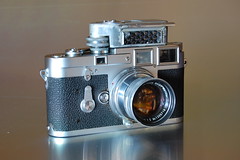
|
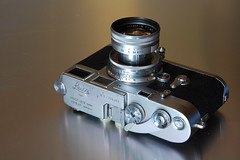
|
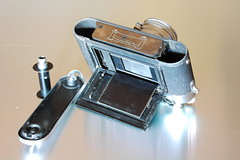
|
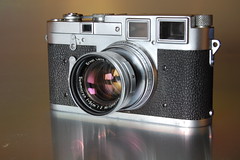
|
| M3 on the left fitted with Leicameter MR Images by Raúl Sá Dantas (Image rights) | |||
Viewfinder
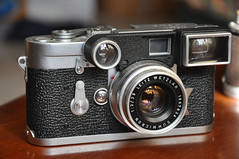
|
| M3 fitted with viewfinder "spectacles" image by M*LoW - Massimo (Image rights) |
Compared to the preceding IIIf, the M3 has an exceptionally bright viewfinder. It also has a high magnification factor, which is very useful in critical focusing. The M3 has a factor of 0.90×, while other Leicas use 0.85×, 0.72×, or less. Furthermore, it was the first Leica to combine rangefinder and viewfinder into one window (other cameras, such as the Contax II, already had this feature before the war and other companies were making screwmount bodies with combined viewfinders). Framelines for 50, 90 and 135mm are shown, although none for any wider lenses. However, Leica solved this problem in two different ways. One was using a separate viewfinder slid into the accessory shoe. The other way is the use of so called Leica glasses; auxiliary lenses are put in front of the viewfinder and rangefinder windows for the 35mm focal length. The drawback of these glasses is they reduce the famed brightness of the finder.
The later M2 with its reduced viewfinder magnification of 0.72× and framelines for 35, 50, and 90mm lenses was introduced primarily at the request of photojournalists who frequently used wide angle lenses.
The 50 mm framelines are always visible in the slightly larger viewfinder image. There are two ways to select the 90mm or 135mm framelines. Mounting a 90mm lens will automatically select the corresponding framelines. The other way is toggling a small lever on the left of the lens. This way, the tele-framelines for other lenses can be seen when using a 50mm lens, which shows the field of view for another focal length.
Viewfinder cameras don't show exactly the same image in the viewfinder as on film (parallax error) which is compensated in the M3 by moving the framelines when focussing the lens. At very close distances this compensation is no longer effective.
Film transport
Leica IIIf and its predecessors had used a knob to advance the film. For fear of tearing the film, early M3s had a double stroke advance lever, just as the Neoca 2S had. Later models had single-stroke levers, which speeded up operation of the camera. Another variation is in the film pressure plate. Early models used a glass plate to keep the film flat, later models used a metal plate.
Shutter
Focal plane shutter, horizontal travel with cloth curtains. Earlier screw mount Leicas had two shutter controls with separate slow and fast speeds which rotated on exposure, as on the Exakta Varex. The M3 combined all speeds on a single static dial, partly to reduce vibrations in the camera.
M2, M1, and MD
|
Leica's model numbering scheme has often caused confusion among users and collectors alike. The next model introduced by Leica was the M2. This was the M3 with reduced viewfinder magnification and a different selection of viewfinder framelines (35, 50, and 90mm). These changes were suggested by professional photojournalists, who were Leica's primary customers at the time. The self timer was initially omitted, but reinstated on later production.
A variant was the M2-Mot introduced in 1967, which could be fitted with a motor winder or the Leicavit rapid winder. The winder with its battery case was larger than the camera body itself.
The M2 was sold alongside the M3 and both continued production with minor changes until eventually replaced by the M4.
The M1 was also based on the M3 body but without a rangefinder, significantly reducing cost.
The MD had no viewfinder at all and was primarily intended to be mounted on a microscope or telescope for use as a scientific instrument camera.
MP
Produced in limited numbers from 1956-57 and available only to established professional photographers. This version of the M3 incorporated the Leicavit rapid winder (manually operated lever on the base) which could not be fitted to the normal M3.[1]
Due to the small number produced this version is highly prized by collectors.
Accessories
|
Special accessories were available to extend the cameras functionality:
The Leicameter MR exposure meter clipped on the to flash shoe and coupled with the shutter dial, providing semi-coupled metering (aperture still had to be manually set on the meter).
The Visoflex reflex housing turned the camera into an SLR. The bayonet mount was the same but with extended lens mount to film plane distance. Normal M lenses could only be used on the Visoflex for close up photography, otherwise special Visoflex lenses with reduced back focus length could be used for normal photography. Visoflex lenses could not be used directly mounted on the camera.
Supplementary viewfinder lenses, often called viewfinder "spectacles", alter magnification for different lenses or close up work.
The Leicavit manually operated rapid winder can be fitted to the M2, but not the M3. The standard base plate is replaced by the winder, which has a fold out lever in the base operated by the right hand, while the left hand works camera controls. Up to three frames per second can be exposed using the Leicavit, which does not require batteries.
Notes
- ↑ Examples offered for sale at the 41st Leitz Photographica Auction, in November 2022 - several excellent detail photographs of each camera:
Links
In English:
- Leica M1 user manual at Butkus.org
- Leica M2 user manual at Butkus.org
- Leica M3 user manual at Butkus.org
- A profile at launch of the Leica M3 in the June, 1954, (Popular) Photography magazine, pgs. 94; 120-121.
- The Leica M Camera Price Guide
- The Leica M3 within Stephen Gandy's Leica M guide
- Leica M3 listed at number 10 in Jason Schneider's Top 20 Cameras Of All-Time on Shutterbug.
- Servicing M series Leicas, at Pentax Manuals
- Leica M3 single stroke by luis triguez
In Spanish:
In French:
- Leica M3 at summilux.net
- Leica M3 1955 on www.collection-appareils.fr by Sylvain Halgand
images by Dries van den Elzen (Image rights)
